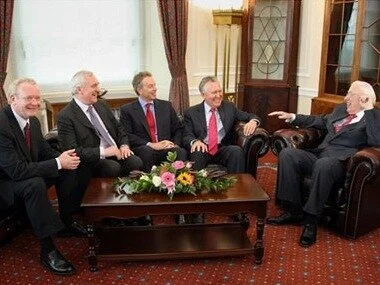The GFA: ‘Power Devolved Is Power Retained’ – Enoch Powell
It is now ten years since the signing of the Belfast Agreement, or the Good Friday Agreement (GFA) as it is more commonly known. The political establishments in Ireland, Britain and further a field are busily lavishing praise on both those who negotiated it, and the political landscape created by it. It is difficult to find a mainstream news article or television piece, which goes beyond the rhetoric to expose the reality of the current situation.
All of this is, of course, to be expected at the denouncement of a British counter-insurgency strategy initiated by General Frank Kitson in the mid 1970s and broadly adhered to by successive British political and military leaders ever since. The GFA and the institutions and context it created are simply complimentary additions to his original three-pronged strategy of ‘Ulsterisation’, ‘Criminalisation’ and ‘Normalisation’.
So as the great and the good crack open the champagne and engage in mutual, and apparently never-ending, back slapping it may be useful for those who support a free Ireland to examine more closely how exactly the British counter-insurgency came to such apparent fruition.
The first prong of ‘Ulsterisation’ entailed the removal of British Troops from the frontline of conflict, to be replaced by a colonial police force such as the RUC or PSNI and local militia such as the UDR or RIR. This process effectively killed two birds with the one stone by stemming the flow of dead British soldiers returning to Britain (with all of the accompanying political fallout) and creating a scenario where the London government could portray the struggle for Irish independence as nothing more than the grubby, sectarian ‘troubles’. Britain’s role in Ireland could then be portrayed as that of honest broker keeping the warring ‘paddies’ from each other’s throats and later as the facilitator of a ‘peace process’.
Another aspect of Ulsterisation, although perhaps not in Kitson’s original plan, has seen an ever-deepening acceptance of partition as a seemingly permanent political reality. The changes made to articles two and three of the Twenty-Six county constitution are just one example of just how far the British government, and their allies in Ireland, have come in convincing people that the national territory of Ireland stops somewhere north of Dundalk and south of Newry. This psychological division is potentially far more damaging than any physical border.
Criminalisation, the second prong of Kitson’s strategy, was itself dual-pronged. On the one hand the liberation struggle was to be portrayed as being little more than a criminal enterprise, with those involved in the struggle being motivated by personal greed, while on the other hand the struggle for national liberation itself was to be categorised as criminal. This strategy was best summed up by Margaret Thatcher in her notorious ‘a crime, is a crime, is a crime’ speech.
While the former was to be achieved through the use of black propaganda, infiltration and agents it was the latter element that represented the most serious threat to Irish republicanism. The jail struggle of the 1970s and 1980s was testament to the importance of this battlefield. The central British position was simple – the Irish people had no right to organise opposition to their rule - most particularly not armed opposition. Any attempt to organise opposition to British rule outside of the gerrymandered parameters laid down by the British government itself was deemed to be ‘criminal’.
The only ‘non-criminal’ mechanism for Irish republicans to pursue their objectives was to be through elections, based upon the unionist veto, to institutions established and controlled by the British state. Thus republicanism was to be slowly confined to a hamster wheel of British defined and controlled struggle. In this regard there could be no space for republicans to pursue a twin track strategy. Instead republicans would need to be convinced through a combination of the carrot and stick to accept that all forms of struggle beyond those deemed acceptable by the British state were criminal.
And finally there was normalisation – the attempt to portray as normal the most abnormal of situations. While war raged on Irish streets the British government sought to convince the wider world that there was no substantial problem in Ireland. But no amount of spin or propaganda could fully hide the truth of their occupation. No amount of landscaping or hanging flower baskets could hide the hundreds of military installations that littered the Six Counties for more than thirty years.
Through the lenses of the Kitson strategy the GFA’s raison d’etre becomes patently clear and the reason for it receiving such universal backing from the political establishment in Ireland and Britain becomes apparent. The GFA had the potential to deliver each and every objective of the British government in Ireland, in a way no amount of troops, black propaganda or piecemeal reform could.
It was and remains a treaty – like so many others in Ireland’s history – designed to entrench and solidify occupation with the acquiescence and support of native politicians. The British government have, through a careful game of brinkmanship and the illusion of negotiation, brought almost all of Ireland’s political leaders to the point of accepting Tony Blair’s assertion that the GFA is ‘the only show in town’. By accepting this analysis one is inherently accepting that all other options, including that of British withdrawal, are unrealistic or unworkable.
It has indisputably been the objective of successive British governments to nullify the Irish national liberation struggle and its revolutionary potential. For them the GFA has become the final solution to the ‘Irish problem’. For its Irish domestic proponents it has become the only option. For the Irish people it has become the all-embracing solidification of foreign political and economic occupation and control.
The British government have, through the GFA, refined their colonial operation for a 21st century Ireland. They have quelled the rebellion and pigeonholed its activists. The need for overt force on the part of the British government has subsided. British occupation forces have been reduced to their pre-1969 garrison levels and nationalist popular resistance has been largely circumvented. Control is now maintained via the vestige of limited powers devolved to the Stormont administration.
Despite all of the superficial changes of recent years the demands of both the national liberation struggle and the civil rights movement remain unmet. The Ireland of today remains occupied and oppressed. And it is this reality, which will give rise to widespread popular resistance to British rule again in the future.
For centuries past the fortunes of the Irish revolution have ebbed and flowed. On numerous occasions republicanism has suffered apparent defeats only to re-emerge stronger and wiser than before. It is highly likely that republicanism is now in such a phase. Ten years on from the Good Friday Agreement republicans need to abandon any thoughts of radical progress within the Stormont assembly, shed any feelings of demoralisation or disillusionment and begin the process of rebuilding opposition to British rule in Ireland again.




